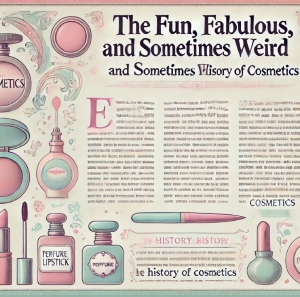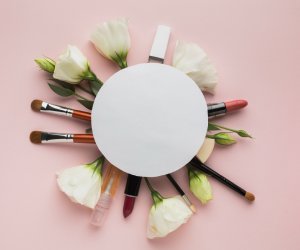
Cosmetics have been part of human society for many years. People of Ancient Egypt used kohl and malachite to emphasize their eyes and protect them from the harsh desert sun. Royalties of Egypt, like Cleopatra, bathed in milk and used natural dyes to keep the skin looking young.
In Ancient Greece, cosmetics were a social statement. Women used white lead to lighten their complexion and rouge for that flushed look. But these beauty products had some pretty awful ingredients.
In Ancient India, for example, Ayurveda developed herbal beauty treatments that utilized such ingredients as turmeric, sandalwood, and rosewater to promote skin health and brightness. Many of these traditions continue to be part of modern Indian skincare.
Other civilizations also embraced cosmetics. The Chinese used rice powder to acquire a pale complexion, while the Romans liked oils, perfumes, and even crushed beetles for red pigment. The Mesopotamians, in turn, produced makeup from natural minerals, showing an early appreciation for self-adornment. These eventually set the stage for modern beauty routines.
Medieval and Renaissance Beauty: From Modesty to Extravagance
During the Medieval Ages, makeup use was restricted due to religious beliefs. The Church viewed excessive cosmetic use as vanity and sin, discouraging women from enhancing their appearance. However, noblewomen still applied subtle herbal mixtures and face powders to maintain their beauty.
A pale complexion was highly desirable, symbolizing wealth and nobility. Since working-class individuals often had tanned skin due to laboring outdoors, aristocrats went to great lengths to maintain fair skin. Women sometimes used harmful substances like arsenic-based powders to achieve a ghostly complexion, a practice that unfortunately led to severe health consequences.
The Renaissance era revived artistic expression in fashion and beauty. Women in France and Italy used lead-based white face paint to achieve a porcelain look. However, many ingredients were toxic, leading to health issues, including lead poisoning. During this period, perfumes became essential among aristocrats, reflecting the growing emphasis on personal grooming. Additionally, elaborate hairstyles adorned with pearls and jewels became a status symbol, emphasizing the importance of beauty in aristocratic circles.
The Beauty Revolution: The Rise of Modern Cosmetics

The 19th century brought significant changes to the beauty industry thanks to advances in science and industrialization. The Industrial Revolution made beauty products widely accessible, and new formulations improved product safety.
However, Queen Victoria of England discouraged makeup use among upper-class women, briefly reducing its popularity. Despite this, actresses and performers continued to use cosmetics, preserving the industry.
The early 20th century marked the birth of modern beauty brands. Iconic companies such as Max Factor, Maybelline, and Revlon revolutionized cosmetics:
Max Factor introduced the first commercially available foundation.
Maybelline created one of the first modern mascaras.
Revlon popularized long-lasting lipsticks and nail polishes.
These innovations made makeup more accessible, safer, and appealing to a wider audience. The rise of photography and motion pictures further fueled the demand for cosmetics, making flawless skin and defined features a new standard of beauty.
Hollywood Glam and Bold Beauty: The 1950s to 1980s
The post-war era saw an explosion in beauty trends heavily influenced by Hollywood stars. Icons like Marilyn Monroe and Audrey Hepburn made bold red lips, winged eyeliner, and flawless skin highly desirable. Cosmetics became more than just a luxury; they were marketed to everyday women.
The 1960s and 1970s introduced bold experimentation:
The mod movement brought pastel eyeshadows, dramatic lashes, and nude lips.
The disco era of the 1970s popularized vibrant and shimmery makeup.
The 1980s embraced excess, with bright blushes, bold eyeshadows, and heavy contouring, reflecting the decade’s flamboyant fashion.
During this time, global beauty standards also expanded, with the rise of Japanese and Korean beauty trends that emphasized dewy skin and natural looks, influencing Western markets.
The Digital Age of Beauty: Technology and Inclusivity
The late 20th and early 21st centuries ushered in a digital revolution in the beauty industry. The rise of social media and beauty influencers transformed how products were marketed and consumed. Platforms like YouTube, Instagram, and TikTok created viral beauty trends, making cosmetics more accessible than ever.
New brands such as MAC, Urban Decay, and Fenty Beauty capitalized on the digital shift, introducing:
A wider range of foundation shades for diverse skin tones.
Cruelty-free and vegan products.
Eco-friendly packaging and sustainable beauty practices.
Advancements in technology also played a crucial role in shaping the industry, with AI-powered beauty apps, virtual try-on tools, and personalized skincare becoming mainstream. Furthermore, the introduction of skincare-infused makeup blurred the lines between cosmetics and skincare, focusing on both aesthetic and dermatological benefits.
Beauty Standards Through Time: Society’s Influence on Cosmetics
Throughout history, societal standards have dictated beauty trends:
In ancient times, makeup signified status and wealth.
The Middle Ages saw a decline in cosmetics due to religious restrictions.
The Renaissance revived artistic expression in makeup and fragrance.
The 1920s flapper movement embraced dark lipstick and short hair as a form of rebellion.
The 1960s introduced fresh-faced beauty ideals, while the 1990s favored minimalism.
Today, beauty is about individuality and self-expression rather than rigid standards.
Tomorrow’s Beauty: The Future of Cosmetics
The beauty industry is focusing on sustainability and innovation. Consumers demand clean beauty, leading brands to prioritize:
Eco-friendly packaging and biodegradable ingredients.
Cruelty-free and vegan formulations.
DNA-based skincare and lab-grown cosmetic ingredients.
Technology continues to transform beauty with AI-driven skincare solutions, virtual makeup try-ons, and personalized beauty recommendations. The fusion of science and beauty is leading to groundbreaking advancements, ensuring that cosmetics remain at the forefront of self-expression and confidence.
Final Thoughts
The history of cosmetics is a chronicle of human ingenuity, cultural evolution, and technological advancement. From kohl-lined eyes in Ancient Egypt to AI-powered beauty solutions today, the times have moved with the industry, inspiring self-expression and artistic innovation. Though the trends may come and go, one thing is certain: Makeup will always emerge as a powerful tool for confidence and beauty.